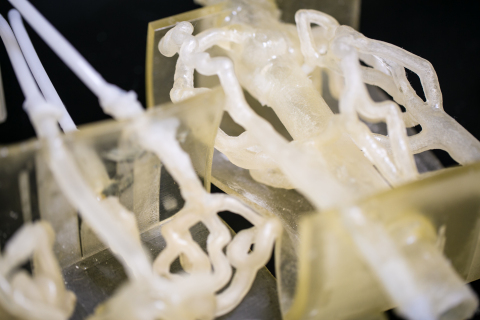Doctors Use 3D Printing to Help Treat Brain Aneurism

Buiilt with flexible TangoPlus, the model of the brain aneurism was able to approximate both the look and feel of the problem area. Courtesy of Stratasys.
Latest News
November 30, 2015
Even with all it has to offer fields such as aerospace and automotive, it’s hard to find an area where additive manufacturing (AM) has made a bigger direct impact on people’s lives than in medicine. Not only can AM be used to build instruments and devices for treatment, doctors can also put 3D printing to use in the planning stages of an operation.
When mother of three, Theresa Flint, visited her doctor complaining of increased headache pain and reduced vision, doctors were able to diagnose her problem as a potentially fatal brain aneurism. Treating a brain aneurism can be difficult, even for experienced surgeons. While doctors can plan a general method of treatment from CT scans and other medical information, there’s no guarantee that the plan will work once in the operating room.
 Buiilt with flexible TangoPlus, the model of the brain aneurism was able to approximate both the look and feel of the problem area. Courtesy of Stratasys.
Buiilt with flexible TangoPlus, the model of the brain aneurism was able to approximate both the look and feel of the problem area. Courtesy of Stratasys.Rather than go in with a partial understanding of the problem and hope for the best, doctors at Kaleida Health’s Gates Vascular Institute turned to 3D printing to develop a model of the problem area. A team drawn from Stratasys, The Jacobs Institute, and the University of Buffalo was assembled to develop the model.
“Typical treatment options are highly risky, as no two cases are identical and require deep understanding of each patient’s unique vascular anatomy. With the aid of Stratasys’ polyJet 3D printing solutions, surgeons at some of the world’s leading hospitals are now able to quickly pinpoint affected areas on individual patients and practice surgeries on realistic anatomical 3D printed models. This is expected to dramatically minimize risks associated with delays and complications stemming from real-time, in-procedure diagnoses,” said Scott Radar, General Manager of Medical Solutions at Stratasys.
The surgical team had initially intended to treat Flint’s brain aneurism with a sort of tiny metal basket delivered through a tiny tube. The team quickly discovered that particular treatment strategy wouldn’t work once they began practicing with the model produced by Stratasys. The doctors were then able to adjust their strategy, avoiding potential complications before they ever happened.
“We took the image of the aneurysm based on her scans to generate an exact replica of the entire brain vessel anatomy. The Stratasys 3D printed model enabled us to devise a much more optimal means to treat her,” said Dr. Adnan H. Siddiqui, Chief Medical Officer at The Jacobs Institute, Vice Chair and Professor of Neurosurgery at The Jacobs School of Medicine and Biomedical Sciences at the University at Buffalo. He is also Director of Neurosurgical Stroke Services for Kaleida Health.
Below you’ll find a video about the procedure.
Source: Stratasys
Subscribe to our FREE magazine, FREE email newsletters or both!
Latest News
About the Author
John NewmanJohn Newman is a Digital Engineering contributor who focuses on 3D printing. Contact him via [email protected] and read his posts on Rapid Ready Technology.
Follow DE





